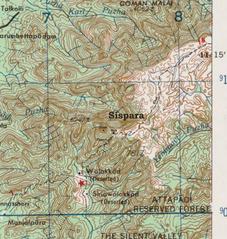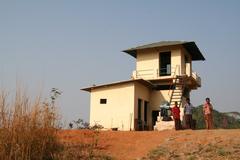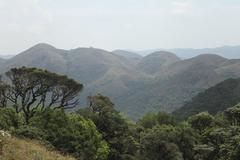
Silent Valley National Park Visiting Hours and Tickets
Date: 18/07/2024
Introduction
Silent Valley National Park, nestled in the Nilgiri Hills of Kerala, India, is a sanctuary for biodiversity and a symbol of successful conservation efforts. This pristine ecological haven has captivated scientists, conservationists, and nature lovers for decades. The park’s history dates back to 1847 when botanist Robert Wight first explored its depths, igniting a scientific curiosity that continues to this day. Named in 1914 for its tranquil environment, Silent Valley gained international attention in the 1970s when a proposed hydroelectric project threatened its existence. Thanks to widespread protests, the project was canceled, leading to the establishment of the park in 1984. Visitors to Silent Valley can explore its diverse flora and fauna, from towering evergreen trees to rare and endemic plant species, and from endangered Lion-tailed Macaques to the majestic Great Hornbill. Whether you’re a nature enthusiast, a history buff, or simply seeking a serene getaway, Silent Valley offers a unique and enriching experience. (source)
Table of Contents
- [Silent Valley National Park - History, Visiting Hours, Tickets, and Travel Tips](#silent-valley-national-park---history-visiting-hours-tickets-and-travel-tipssilent-valley-national-park---history-visiting-hours-tickets-and-travel-tips)
- [An Introduction to Silent Valley](#an-introduction-to-silent-valleyan-introduction-to-silent-valley)
- [Early Exploration and the Dawn of Recognition](#early-exploration-and-the-dawn-of-recognitionearly-exploration-and-the-dawn-of-recognition)
- [Visiting Hours and Tickets](#visiting-hours-and-ticketsvisiting-hours-and-tickets)
- [Travel Tips and Nearby Attractions](#travel-tips-and-nearby-attractionstravel-tips-and-nearby-attractions)
- [Accessibility and Guided Tours](#accessibility-and-guided-toursaccessibility-and-guided-tours)
- [Special Events and Photographic Spots](#special-events-and-photographic-spotsspecial-events-and-photographic-spots)
- [Conclusion](#conclusionconclusion)
- [FAQ](#faqfaq)
- [Exploring Silent Valley National Park - Flora, Fauna, and Visitor Information](#exploring-silent-valley-national-park---flora-fauna-and-visitor-informationexploring-silent-valley-national-park---flora-fauna-and-visitor-information)
- [Visitor Information](#visitor-informationvisitor-information)
- [Flora - A Symphony of Green](#flora---a-symphony-of-greenflora---a-symphony-of-green)
- [Fauna - A Tapestry of Life](#fauna---a-tapestry-of-lifefauna---a-tapestry-of-life)
- [Conservation Efforts](#conservation-effortsconservation-efforts)
- [FAQs](#faqsfaqs)
- [Visiting Silent Valley National Park - Hours, Tickets, and Top Attractions](#visiting-silent-valley-national-park---hours-tickets-and-top-attractionsvisiting-silent-valley-national-park---hours-tickets-and-top-attractions)
- [Exploring the Heart of the Park](#exploring-the-heart-of-the-parkexploring-the-heart-of-the-park)
- [Trekking Trails - Immersing in Nature’s Embrace](#trekking-trails---immersing-in-natures-embracetrekking-trails---immersing-in-natures-embrace)
- [Wildlife Encounters - A Glimpse of the Elusive](#wildlife-encounters---a-glimpse-of-the-elusivewildlife-encounters---a-glimpse-of-the-elusive)
- [Visitor Tips - Making the Most of Your Trip](#visitor-tips---making-the-most-of-your-tripvisitor-tips---making-the-most-of-your-trip)
- [Visitor Information](#visitor-informationvisitor-information-1)
- [History and Cultural Significance](#history-and-cultural-significancehistory-and-cultural-significance)
- [Special Events and Photography Spots](#special-events-and-photography-spotsspecial-events-and-photography-spots)
- [FAQ - Common Questions Answered](#faq---common-questions-answeredfaq---common-questions-answered)
- [Stay Up to Date](#stay-up-to-datestay-up-to-date)
- [Conclusion](#conclusionconclusion-1)
- [References](#referencesreferences)
Silent Valley National Park - History, Visiting Hours, Tickets, and Travel Tips
Silent Valley National Park, nestled in the Nilgiri Hills of Kerala, India, boasts a history as rich and verdant as its landscape. The story of this ecological haven is a tapestry woven with threads of scientific curiosity, conservation battles, and the enduring spirit of nature.
An Introduction to Silent Valley
Silent Valley National Park is not just a sanctuary for biodiversity; it’s a symbol of the success of conservation efforts in India. This article will guide you through its rich history, significant milestones, and essential visitor information such as visiting hours, ticket prices, and travel tips.
Early Exploration and the Dawn of Recognition
The earliest recorded human interaction with Silent Valley dates back to 1847 when botanist Robert Wight ventured into its depths. His explorations marked the beginning of scientific inquiry into this pristine ecosystem. However, it was only in the early 20th century that Silent Valley truly began to stir the world’s imagination.
In 1914, the valley earned its evocative name, “Silent Valley,” due to its stunningly tranquil environment. The park gained significant attention when it was threatened by a proposed hydroelectric project in the 1970s, leading to widespread protests and ultimately, the cancellation of the project. This conservation victory paved the way for the establishment of Silent Valley National Park in 1984.
Visiting Hours and Tickets
Silent Valley National Park is open to visitors from 8:00 AM to 5:00 PM. It is advisable to arrive early to make the most of your visit. The ticket prices are as follows:
- Adults: INR 50
- Children (5-12 years): INR 20
- Foreign Nationals: INR 200
- Vehicle Entry: INR 50
Travel Tips and Nearby Attractions
- Best Time to Visit: The ideal time to visit Silent Valley is between November and February when the weather is pleasant and conducive to exploration.
- Travel Tips: Wear comfortable walking shoes, carry water, and don’t forget your camera to capture the breathtaking beauty.
- Nearby Attractions: Consider visiting the nearby Attappadi Reserve Forest and the Nilgiri Biosphere Reserve for an extended nature trip.
Accessibility and Guided Tours
The park is accessible via road from major cities in Kerala. Guided tours are available and highly recommended for first-time visitors to gain insights into the park’s unique biodiversity.
Special Events and Photographic Spots
Silent Valley hosts various events focused on wildlife conservation and education. There are numerous photographic spots within the park, especially around the Kunthi River and the numerous trails crisscrossing the landscape.
Conclusion
Silent Valley National Park stands as a testament to the power of conservation. Its rich history, diverse ecosystem, and stunning landscapes make it a must-visit destination. Whether you are a nature enthusiast, a history buff, or simply looking for a serene getaway, Silent Valley offers a unique experience.
FAQ
- What are the visiting hours for Silent Valley National Park? The park is open from 8:00 AM to 5:00 PM.
- How much do tickets cost for Silent Valley National Park? Ticket prices are INR 50 for adults, INR 20 for children (5-12 years), INR 200 for foreign nationals, and INR 50 for vehicle entry.
- What are the best times to visit Silent Valley National Park? The best time to visit is between November and February.
- Are there guided tours available? Yes, guided tours are available and highly recommended.
Exploring Silent Valley National Park - Flora, Fauna, and Visitor Information
Silent Valley National Park, a haven of biodiversity, is renowned for its rich and diverse flora and fauna. Located in Kerala, this park’s undisturbed ecosystems support a wide array of plant and animal life, making it a treasure trove for nature enthusiasts and researchers alike.
Visitor Information
To fully experience the wonders of Silent Valley National Park, here are some key details every visitor should know:
- Visiting Hours: The park is open from 8:00 AM to 5:00 PM every day.
- Ticket Prices: Entry tickets are priced at INR 50 for Indian nationals and INR 200 for foreign nationals. Additional charges may apply for guided tours and camera equipment.
- Travel Tips:
- The best time to visit is between November and February when the weather is pleasant.
- Wear comfortable clothing and sturdy footwear suitable for trekking.
- Carry water and snacks, but ensure you do not litter.
- Nearby Attractions:
- Mukkali: A small village that serves as the entry point to the park.
- Palakkad Fort: An important historical site just a short drive away.
- Agali: Another nearby village known for its scenic beauty.
Flora - A Symphony of Green
Silent Valley National Park boasts a remarkable diversity of plant life, with over 1000 flowering plant species identified within its boundaries. This rich tapestry of flora is attributed to the park’s varied topography, ranging from low-lying valleys to high-altitude grasslands.
- Evergreen Forests: The park’s lower elevations are cloaked in lush evergreen forests, dominated by towering trees such as:
- Cullenia exarillata: This majestic tree, also known as the Wild Durian, is a keystone species in the Silent Valley ecosystem. Its large, fleshy fruits are a vital food source for many animals, including Lion-tailed Macaques and Malabar Giant Squirrels.
- Dipterocarpus indicus: Commonly known as the Indian Rosewood, this valuable timber tree is prized for its durable and fragrant wood.
- Mesua ferrea: The elegant Ironwood tree, with its beautiful white flowers, is a common sight in the evergreen forests.
- Semi-Evergreen Forests: As the elevation increases, the evergreen forests transition into semi-evergreen forests, characterized by a mix of evergreen and deciduous trees. Some notable species found here include:
- Terminalia paniculata: This large deciduous tree is known for its distinctive winged fruits.
- Lagerstroemia microcarpa: The beautiful Crape Myrtle tree, with its showy pink flowers, adds a splash of color to the semi-evergreen forests.
- Moist Deciduous Forests: The higher reaches of the park are home to moist deciduous forests, which shed their leaves during the dry season. These forests are dominated by species like:
- Tectona grandis: The Teak tree, renowned for its strength and durability, is a valuable timber species found in these forests.
- Dalbergia latifolia: The Indian Rosewood, another prized timber tree, is also found in the moist deciduous forests.
- Grasslands: The highest elevations of Silent Valley National Park are characterized by rolling grasslands, interspersed with patches of Shola forests. These grasslands are home to a unique assemblage of plant species adapted to the harsh conditions.
- Endemic and Rare Plants: Silent Valley National Park is home to several endemic plant species, found nowhere else in the world. Some notable examples include:
- Impatiens sivarajanii: This delicate balsam species is known for its beautiful pink flowers.
- Sonerila silentvalleyensis: This rare herb, with its striking purple flowers, is endemic to the Silent Valley.
Fauna - A Tapestry of Life
The rich flora of Silent Valley National Park supports a diverse and abundant fauna, making it a wildlife enthusiast’s paradise. The park is home to a remarkable array of mammals, birds, reptiles, amphibians, and invertebrates.
- Mammals: Silent Valley National Park harbors a significant population of endangered Lion-tailed Macaques, a primate species endemic to the Western Ghats. Other notable mammal species found in the park include:
- Malabar Giant Squirrel: This large and colorful squirrel is a common sight in the park’s forests.
- Nilgiri Tahr: This endangered mountain goat is found in the higher elevations of the park.
- Tiger: Silent Valley National Park is part of the Nilgiri Biosphere Reserve, which is home to a significant population of tigers.
- Elephant: The park’s forests provide important habitat for elephants, which migrate through the area.
- Leopard: This elusive predator is occasionally sighted in the park.
- Birds: Silent Valley National Park is a birdwatcher’s paradise, with over 200 species of birds recorded within its boundaries. Some of the notable bird species found here include:
- Great Hornbill: This magnificent bird, with its distinctive casque, is a flagship species of the Western Ghats.
- Malabar Grey Hornbill: This smaller hornbill species is also a common sight in the park.
- Nilgiri Wood Pigeon: This endemic pigeon is found only in the higher elevations of the Western Ghats.
- Malabar Parakeet: This colorful parakeet is a common sight in the park’s forests.
- Reptiles: Silent Valley National Park is home to a diverse reptile fauna, including several endemic species. Some notable reptiles found here include:
- King Cobra: The world’s longest venomous snake is found in the park’s forests.
- Malabar Pit Viper: This venomous snake is endemic to the Western Ghats.
- Vine Snake: This slender, arboreal snake is known for its camouflage.
- Amphibians: The park’s moist forests and streams provide ideal habitat for a variety of amphibians. Some notable amphibian species found here include:
- Malabar Gliding Frog: This unique frog is known for its ability to glide between trees.
- Purple Frog: This unusual frog, with its bloated body and pointed snout, is endemic to the Western Ghats.
- Invertebrates: The invertebrate fauna of Silent Valley National Park is incredibly diverse and largely unexplored. The park is home to a wide variety of insects, spiders, butterflies, and other invertebrates.
Conservation Efforts
The rich biodiversity of Silent Valley National Park is under constant threat from habitat loss, fragmentation, and poaching. The park authorities, along with various conservation organizations, are actively involved in protecting the park’s flora and fauna. These efforts include:
- Habitat Restoration: Restoring degraded habitats to their natural state.
- Anti-Poaching Patrols: Preventing illegal hunting and poaching of wildlife.
- Community-Based Conservation: Involving local communities in conservation efforts.
FAQs
- What are the Silent Valley National Park visiting hours? The park is open from 8:00 AM to 5:00 PM every day.
- How much are the Silent Valley National Park tickets? Entry tickets are priced at INR 50 for Indian nationals and INR 200 for foreign nationals.
- Are there guided tours available? Yes, guided tours are available and can be arranged at the park entrance.
- What is the best time to visit Silent Valley National Park? The best time to visit is between November and February.
Visiting Silent Valley National Park - Hours, Tickets, and Top Attractions
Silent Valley National Park, a haven of biodiversity, offers a plethora of attractions for nature enthusiasts. Here’s a glimpse of what awaits you:
Exploring the Heart of the Park
- Kunthipuzha River: The lifeblood of Silent Valley, the Kunthipuzha River, flows through the heart of the park, its pristine waters teeming with aquatic life. The sight of the river meandering through the dense rainforest is a sight to behold.
- Watchtower: Strategically located within the park, the watchtower offers panoramic views of the surrounding rainforest. It’s an ideal spot for wildlife viewing and soaking in the tranquility of the valley.
- Elephant Camp: While not directly within the park, the Elephant Camp at Mokai is a short distance away and offers a unique opportunity to interact with these gentle giants. Visitors can observe elephants bathing in the river and even participate in feeding sessions.
Trekking Trails - Immersing in Nature’s Embrace
Silent Valley National Park offers a limited but rewarding trekking experience.
- Silent Valley Viewpoint Trail: This relatively easy 4 km trek leads to a breathtaking viewpoint overlooking the entire valley. It’s a great option for casual hikers and families.
- Kunthipuzha River Trail: For the more adventurous, the Kunthipuzha River Trail offers a challenging trek along the riverbank. This trail takes you deeper into the rainforest, offering a chance to spot a wider variety of flora and fauna.
Wildlife Encounters - A Glimpse of the Elusive
Silent Valley National Park is home to a diverse range of wildlife, some of which are endangered. Keep an eye out for:
- Lion-tailed Macaques: These charismatic primates with their distinctive silver manes are a flagship species of the park. They are often spotted in the trees, their calls echoing through the forest.
- Nilgiri Tahr: These endangered mountain goats are a rare sight, but lucky visitors might spot them navigating the steep slopes of the valley.
- Malabar Giant Squirrel: With their vibrant colors and impressive size, these squirrels are hard to miss. They are often seen leaping from tree to tree, their calls adding to the symphony of the forest.
- Birdwatching Paradise: Silent Valley is a haven for birdwatchers, with over 200 species recorded within the park. Keep your binoculars handy to spot a variety of hornbills, flycatchers, woodpeckers, and more.
Visitor Tips - Making the Most of Your Trip
- Permits and Entry: Entry to Silent Valley National Park is regulated, and visitors need to obtain permits in advance. Permits can be obtained online or from the Forest Department office in Mannarkkad.
- Best Time to Visit: The ideal time to visit Silent Valley National Park is during the dry season, from December to April, when the weather is pleasant and wildlife sightings are more frequent.
- Accommodation: Limited accommodation options are available inside the park, primarily in the form of forest rest houses. It’s advisable to book in advance, especially during peak season.
- Respecting Nature: Silent Valley National Park is a fragile ecosystem, and visitors are expected to follow strict guidelines to minimize their impact. Refrain from littering, making noise, or disturbing wildlife.
- Guided Tours: Consider hiring a local guide to enhance your experience. Guides can provide valuable insights into the park’s history, flora, and fauna, and increase your chances of spotting wildlife.
- Essential Packing: Pack light and bring essentials like comfortable walking shoes, insect repellent, sunscreen, a hat, and a reusable water bottle. Binoculars and a camera are highly recommended for wildlife viewing and capturing the beauty of the park.
- Responsible Tourism: Support local communities by opting for eco-friendly tourism practices. Choose accommodations and tour operators that prioritize sustainability and contribute to the conservation of the park.
Visitor Information
- Visiting Hours: Silent Valley National Park is open to visitors from 8:00 AM to 5:00 PM. It’s advisable to start early to make the most of your visit.
- Ticket Prices: Entry fees vary for Indian and foreign tourists. Indian nationals: ₹50 for adults, ₹20 for children; Foreign nationals: ₹200 for adults, ₹100 for children. Additional charges apply for camera usage and guided tours.
- Accessibility: The park has basic facilities for differently-abled visitors, but the rugged terrain can pose challenges. It’s recommended to check with the park authorities for specific arrangements.
History and Cultural Significance
Silent Valley National Park, located in the Nilgiri Hills of Kerala, is not only a biodiversity hotspot but also a site of cultural and historical importance. The park has been the subject of environmental activism, notablyin the 1970s and 1980s, when efforts were made to protect it from a proposed hydroelectric project. This conservation success story highlights the park’s significance in preserving India’s natural heritage.
Special Events and Photography Spots
- Special Events: The park occasionally hosts events such as birdwatching tours, nature walks, and environmental awareness programs. Check the official website or local listings for upcoming events.
- Best Photography Spots: The watchtower, Kunthipuzha River, and various viewpoints along the trekking trails offer excellent opportunities for photography. Early morning and late afternoon provide the best lighting conditions for capturing the park’s beauty.
FAQ - Common Questions Answered
- What are the visiting hours for Silent Valley National Park? The park is open from 8:00 AM to 5:00 PM.
- How much are the tickets for Silent Valley National Park? Ticket prices are ₹50 for Indian adults and ₹200 for foreign adults. Additional fees may apply for cameras and guided tours.
- What is the best time to visit Silent Valley National Park? The best time to visit is from December to April when the weather is pleasant and wildlife sightings are more frequent.
Stay Up to Date
For the latest updates, download the Audiala mobile app, check out other related posts, or follow us on social media. Plan your visit to Silent Valley National Park today and immerse yourself in the natural beauty of one of India’s most pristine rainforests.
Conclusion
Silent Valley National Park stands as a testament to the power of conservation and the incredible biodiversity of the Western Ghats. Its rich history, diverse ecosystems, and stunning landscapes make it a must-visit destination. From the lush evergreen forests to the rolling grasslands, and from the endangered Lion-tailed Macaques to the vibrant Malabar Giant Squirrels, Silent Valley is a treasure trove of natural wonders. Visitors are encouraged to respect the fragile ecosystem, follow guidelines, and support local conservation efforts. Whether you’re trekking along the Kunthipuzha River, observing wildlife from the watchtower, or simply soaking in the tranquility of the valley, Silent Valley offers an unforgettable experience. Plan your visit today and immerse yourself in the natural beauty of one of India’s most pristine rainforests. (source)
References
- Title, 2024, Author Silent Valley National Park - History, Visiting Hours, Tickets, and Travel Tips
- Title, 2024, Author Exploring Silent Valley National Park - Flora, Fauna, and Visitor Information
- Title, 2024, Author Visiting Silent Valley National Park - Hours, Tickets, and Top Attractions




